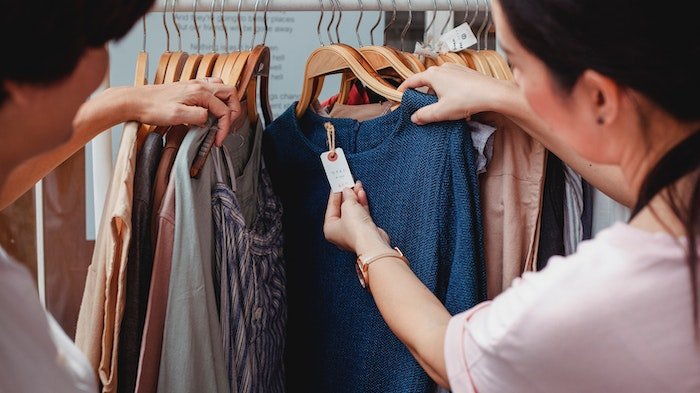- Home
- Types of Addiction
- Compulsive Shopping Help & Treatment
Compulsive Shopping Help & Treatment
Shopping addiction can be difficult to understand because so many people enjoy shopping.
Shopping at the weekend or happily spending a little extra during special occasions such as Christmas is usually normal shopping behaviour.
A shopping addiction goes beyond the normal scope of shopping.
Shopping addiction is when you cannot resist the urge to shop and become obsessed with the idea of shopping to the point that it begins to consume your every thought.
You may have several store cards and credit cards to help you fund your shopping addiction, and your financial well-being will likely suffer as a result.
Suffering from a shopping addiction can be difficult to overcome because shopping is so widely accepted to be a completely normal part of life. Many people measure social status on the number of material things a person has and this can make a shopping addiction worse.
The ease with which most of us can shop online has also added to the rise in problematic shopping behaviour. (1)
What is a Shopping Addiction?

While it may not have the same negative connotations as a drug or alcohol addiction – a shopping addiction can be just as destructive and problematic.
Also known as ‘oniomania’, compulsive shopping disorder is relatively unknown or discussed when it comes to discussions about addiction. (2)
Simply put, a shopping addiction is when someone has an overwhelming and compulsive need to shop.
Someone with a shopping addiction will likely feel intense anxiety in the run-up to making a purchase, only to feel extreme euphoria once they have made a purchase, and then feel guilt or shame afterwards.
Over time, the person will seek the euphoric feeling they felt when they made a purchase and associate shopping with that positive emotion.
Characteristics of Compulsive Shopping
If you are worried that you or someone you know might be struggling with a shopping addiction, it is helpful to know the characteristics of a compulsive shopping disorder.
Some of the most common characteristics are:
- An overwhelming need to shop
- Routinely purchasing items that are not needed
- Talking about or thinking about shopping constantly
- Financial difficulties due to the amount of money spent on shopping
- Spending a lot of time looking for new things they can buy
- Leaving work or school to shop, or shop online when they should be working/studying
Normal vs. Compulsive Shopping
Most people have overspent for special occasions including birthdays and Christmas. In these cases, some people may worry that they have developed an addiction to shopping because of how much money they have spent.
However, compulsive shopping is less about the amount of money spent, and more about the overwhelming need to shop.
Someone with a shopping addiction will be obsessed with shopping and the idea of it, regardless of the time of year it is and without consideration for any negative consequences of their shopping trips.
What Causes Shopping Addiction?
A shopping addiction follows a similar trajectory to other addictions. Generally, someone with a shopping addiction will feel a rush when they make a purchase, and they will be trying to chase that feeling.
While a shopping addiction can affect anyone, you may be more likely to develop a compulsive shopping disorder if you face any of the following:
- Loneliness
- Feelings of emptiness or longing
- Lacking emotional relationships
- Compulsiveness
- A need to control something
- Seeking approval from others
How Do I Know Whether I Have a Shopping Addiction or Just Like to go on Shopping Sprees?

You may be concerned that you have developed a shopping addiction if you have recently gone on a spending spree and perhaps overspent. While a shopping addiction and a shopping spree have certain similarities, there are some factors that set them apart.
A shopping spree is usually a one-off. During a shopping spree, you may spend more than usual and maybe even more than you are comfortable spending.
However, you will rarely go over a certain limit of affordability – even if you do splurge.
You may also buy more items than you would usually buy, but you will be aware that this is a one-off and won’t be too hard on yourself about it.
While a shopping spree is most commonly linked to birthdays or Christmas, it can happen at any time. Even if you go on a shopping spree at a random time, you will usually understand that this is not something that you can do too often and you will be able to reign yourself in before you go overboard.
A shopping addiction does not just happen for a special occasion. Someone with a shopping addiction will routinely buy more items than is necessary and spend more money than they can afford.
Someone with a shopping addiction may go on several shopping sprees per week and will have financial difficulties due to an excessive amount of credit cards and store cards.
Shopping Addiction vs. Substance Addiction
While there are clear differences between a shopping addiction and a substance addiction, it is important to remember that a shopping addiction can also be harmful and difficult to overcome.
The most obvious difference between a shopping addiction and a substance addiction is that a shopping addiction does not rely on external chemicals to alter the brain. This means that compulsive shopping does not cause a physical addiction of which one would require a medical detox to overcome.
That being said, there are several substances that also do not cause a physical addiction.
A shopping addiction works in a similar way to other addiction, so when someone with compulsive shopping disorder makes a purchase, their brain’s reward centre releases dopamine – the feel good hormone. This gives the person a rush of pleasure which they try to find over and over.
Substance addiction works in a similar way, so when someone uses a substance, their brain will release dopamine, and they will associate that pleasurable feeling with the substance in question.
Someone with a shopping addiction does not face health problems as a direct result of their addiction. While someone with a substance addiction will likely face physical health conditions if their addiction is untreated.
However, someone with a shopping addiction is likely to face serious financial problems far quicker than those with a substance addiction.
Either way, addiction needs to be addressed as soon as possible to ensure you have a higher chance of overcoming the addiction and moving on.
Types of Shopping Addiction
While some compulsive shoppers may focus on one type of product, others may focus on any item they consider to be a bargain.
For example, some people with a shopping addiction might buy excessive amounts of shoes, while someone else might buy lots of electrical equipment. On a larger scale, someone might compulsively buy cars.
There are various categories of a compulsive shopper, however, it is important to note that while some people with a compulsive shopping disorder may fit into one of these categories, others may not.
Some common categories are:
- Bargain lovers – people with an obsession for bargains will buy products simply because they are on sale. This makes them feel like they are getting a deal and can sometimes make them feel less guilty for their addiction because they haven’t paid full price for the item – even if they did not have a need for the item in the first place.
- Collectors – some people disguise their shopping addiction as a love for a particular thing and collect items relating to the thing they enjoy. People might collect items relating to certain famous people, they could also collect items from a particular era in time or items relating to certain movie franchises. Collecting items can be costly and time-consuming.
- Show-offs – some people want to buy things specifically because they feel that other people will be impressed by them. These people may spend large amounts of money on designer clothes or expensive cars. People with this type of shopping addiction often associate their self-worth with others’ opinions of them.
- Emotional shoppers – these people will shop as a way to try to lift their mood and make themselves feel happier. They will have a momentary feeling of euphoria when they buy something, but that feeling will be short-lived and they will repeat the cycle over and over again.
- Trophy hunters – these people will look for rare or one-of-a-kind items. The quest of sourcing these rare items and the subsequent high they feel when they find it and purchase it are what makes the experience so addictive to them.
Stages of a Shopping Addiction
It can be dangerous to write a ‘checklist’ of the different stages of any addiction. This is because every addiction is different, and different people have different experiences of addiction.
If someone were to create a list of stages that described a shopping addiction that did not fit with someone’s experience, they may wrongly believe that they do not have a problem and subsequently not seek help.
However, researchers have put together a list of phases that someone experiencing compulsive buying might go through.
These phases are:
- Phase 1. Retail therapy, “Filling up emptiness with shopping”
- Phase 2. Denial, “Ignoring overconsumption”
- Phase 3. Debt-ridden, “Ran out of money, while nothing left”
- Phase 4. Impulsive buying, “Driving ones-self to hasty buying”
- Phase 5. Compulsive buying, “It is crazy but I cannot stop.” (3).
Causes of Shopping Addiction
As with every addiction – particularly behavioural ones – there is no specific cause of addiction and research into what causes addiction is ongoing.
As previously mentioned, different people have different experiences of addiction, and so the reasons some people develop addictions will be different from person to person.
That being said, it is generally understood that there are some environmental, genetic and emotional factors in play when an addiction develops.
In the digital age, shopping is becoming easier and easier and people who would normally have put off shopping due to anxiety can now sit in the comfort of their homes and shop as much as they want.
The ease with which people can shop, teamed with underlying mental health conditions such as depression can be a recipe for disaster.
What are the Treatments for Shopping Addiction?

Treating a shopping addiction can be difficult because people need to make purchases as part of their day-to-day lives.
Often, rehabs will focus on abstaining from the activity to help you overcome an addiction, however, it is virtually impossible to abstain from buying things because we all need food and personal products.
In severe cases, another person may need to take full financial control of someone with a shopping addiction to make sure that they are not overspending.
However, in most cases, compulsive shopping disorder can be treated with therapy.
Individual therapy will help the person get to the root cause of their addiction – whether it stems from childhood trauma or some other emotional trigger, a trained therapist will help to uncover underlying mental health conditions that might be contributing to the addiction.
Get Help Today

If you are worried about yourself or a loved one’s shopping habits, you can call one of our addiction experts any time on 0800 088 66 86.
Our team of friendly specialists here at Rehab Recovery are available 24 hours a day and can offer free and non-judgemental advice on any addiction issues you or your loved ones may be facing.
References
[1] National Library of Medicine – Towards an understanding of Internet-based problem shopping behaviour: The concept of online shopping addiction and its proposed predictors – https://www.ncbi.nlm.nih.gov/pmc/articles/PMC4117286/
[2] National Library of Medicine – [Compulsive buying or oniomania: an overview] – https://pubmed.ncbi.nlm.nih.gov/20054795/
[3] International Journal of Mental Health and Addiction – Phases of Shopping Addiction Evidenced by Experiences of Compulsive Buyers – https://link.springer.com/article/10.1007/s11469-013-9449-y


